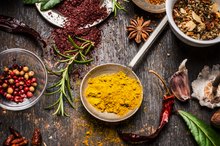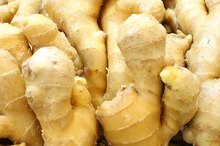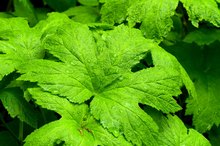Side Effects of Echinacea & Goldenseal
Many people turn to herbs for medicinal use as an alternative to commercially produced medications. Goldenseal and echinacea are two of the most commonly purchased herbs in the United States, according to the University of Maryland Medical Center. The two are often taken together as a treatment for the common cold and to bolster the immune system to prevent infections. Neither herb has been conclusively proven effective in the treatment of colds or upper respiratory infection or as an immune booster, although some studies show benefits.
Uses of Echinacea
Echinacea is a perennial herb related to the daisy. Common names for echinacea include purple coneflower, Sampson root and Missouri snakeroot. Echinacea is used not only to stave off colds and the flu by stimulating the immune system but also as an antioxidant and antiviral medication. Proponents of echinacea also use it to reduce inflammation and relieve pain. While some studies have shown that echinacea might reduce the severity and duration of colds somewhat, not all studies are well designed and they use varying amounts of echinacea, UMMC cautions. In Germany, where the government regulates the use of herbs, the above-ground part of echinacea is approved for treating upper respiratory infections, urinary tract infections and wounds.
- Echinacea is a perennial herb related to the daisy.
- While some studies have shown that echinacea might reduce the severity and duration of colds somewhat, not all studies are well designed and they use varying amounts of echinacea, UMMC cautions.
Echinacea Side Effects
Is it Safe to Take Echinacea & Goldenseal While Breastfeeding?
Learn More
The University of Maryland Medical Center recommends 1 to 2 grams of dried root or herb, as tea or 300 mg of standardized, powdered extract for no more than seven to 10 days. When taken by mouth, it can cause nausea, sore throat and numbness and tingling in the mouth. If you're allergic to other plants in the daisy family, you may not be able to take echinacea. If you have multiple sclerosis, diabetes, HIV/AIDS or liver disease, take iechinacea only under your doctor's supervision. If you take immunosuppressive medication, do not take echinacea. Children and pregnant or breastfeeding women should not take echinacea unless their doctor approves its use.
- The University of Maryland Medical Center recommends 1 to 2 grams of dried root or herb, as tea or 300 mg of standardized, powdered extract for no more than seven to 10 days.
- If you have multiple sclerosis, diabetes, HIV/AIDS or liver disease, take iechinacea only under your doctor's supervision.
Uses of Goldenseal
Goldenseal is related to the buttercup; its other names are yellow root, jaundice root, eye root and poor man's ginseng. Goldenseal contains the active compound berberine, which proponents of the herb claims acts as an antibacterial agent, although studies haven't proven this, the UMMC states. Berberine may stimulate production of white blood cells, which are needed to fight infection. Goldenseal is also used as a digestive tonic, mouthwash, eye wash and disinfectant for minor scrapes and cuts. contrary to common opinion, taking goldenseal won't block drug tests from detcting illegal substances, accordng to the UMMC.
- Goldenseal is related to the buttercup; its other names are yellow root, jaundice root, eye root and poor man's ginseng.
- Goldenseal contains the active compound berberine, which proponents of the herb claims acts as an antibacterial agent, although studies haven't proven this, the UMMC states.
Goldenseal Side Effects
Natural Antibiotic for Gum Disease
Learn More
Goldenseal is considered safe when used for short periods of time, but few studies have been done to evaluate its long term use, and goldenseal's antibacterial action could destroy good as well as harmful bacteria if used for an extended time. The University of Maryland Medical Center recommends adults take 500 to 1,000 mg of goldenseal in capsule form or 30 to 120 mg of standardized extract three times daily. It is not recommended for use in children. Side effects, such as nausea, vomiting, skin irritation and sensitivity to sunlight, are rare. If you have high blood pressure, heart disease, liver disease or are taking anticoagulant medication or tetracycline, do not take goldenseal. It can also cause jaundice in newborns, so do not take this herb if you are pregnant or breastfeeding.
- Goldenseal is considered safe when used for short periods of time, but few studies have been done to evaluate its long term use, and goldenseal's antibacterial action could destroy good as well as harmful bacteria if used for an extended time.
Related Articles
References
- University of Maryland Medical Center: Goldenseal
- University of Maryland Medical Center: Echinacea
- National Center for Complementary and Alternative Medicine: Goldenseal
- Memorial Sloan Kettering Integrative Medicine About Herbs, Botanicals & Other Products. Echinacea. https://www.mskcc.org/cancer-care/integrative-medicine/herbs/echinacea
- Natural Medicines Database: Therapeutic Research Center. Echinacea. https://naturalmedicines.therapeuticresearch.com/databases/food,-herbs-supplements/professional.aspx?productid=981
- UCLA Center for East-West Medicine. The Echinacea Controversy: Herbal Remedy for Colds? https://exploreim.ucla.edu/wellness/the-echinacea-controversy-herbal-remedy-for-colds/
- Restani P, Di Lorenzo C, Garcia-Alvarez A, et al. Adverse Effects of Plant Food Supplements Self-Reported by Consumers in the PlantLIBRA Survey Involving Six European Countries. PLoS One. 2016;11(2):e0150089. doi:10.1371/journal.pone.0150089
- Senica M, Mlinsek G, Veberic R, Mikulic-petkovsek M. Which Plant Part of Purple Coneflower (Echinacea purpurea (L.) Moench) Should be Used for Tea and Which for Tincture? J Med Food. 2019;22(1):102-108. doi:10.1089/jmf.2018.0026
- Wanwimolruk S, Prachayasittikul V. Cytochrome P450 enzyme mediated herbal drug interactions (Part 1). EXCLI J. 2014;13:347-391.
- Karsch-Völk M, Barrett B, Kiefer D, Bauer R, Ardjomand-Woelkart K, Linde K. Echinacea for preventing and treating the common cold. Cochrane Database Syst Rev. 2014;2(2):CD000530. doi:10.1002/14651858.CD000530.pub3
- National Center for Complementary and Integrative Health. Echinacea. Updated September 2016.
- Brown PN, Chan M, Paley L, Betz JM. Determination of major phenolic compounds in Echinacea spp. raw materials and finished products by high-performance liquid chromatography with ultraviolet detection: single-laboratory validation matrix extension. J AOAC Int. 2011;94(5):1400-1410.
- Hudson JB. Applications of the phytomedicine Echinacea purpurea (Purple Coneflower) in infectious diseases. J Biomed Biotechnol. 2012;2012:769896. doi:10.1155/2012/769896
- Memorial Sloan Kettering Integrative Medicine About Herbs, Botanicals & Other Products. Echinacea.
- Natural Medicines Database: Therapeutic Research Center. Echinacea.
- UCLA Center for East-West Medicine. The Echinacea Controversy: Herbal Remedy for Colds?
Writer Bio
Kathryn Meininger began writing and publishing poetry in 1967. She was co-founder and editor of the professional magazine "Footsteps" and began writing articles online in 2010. She earned a Doctor of Podiatric Medicine from Temple University School of Podiatric Medicine and a Bachelor of Arts in biology from William Paterson University.









